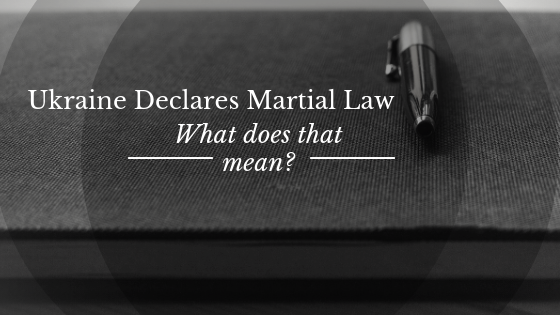If you’ve watched or listened to the news recently, you may have heard that Ukraine has officially declared martial law in 10 out of 27 regions as a result of recent activity on and near the Crimean Peninsula. The declaration does not come as a surprise, however many individuals are questioning its timing.
What is martial law?
The technical definition of martial law is as follows:
“The temporary imposition of military rule over a state or region in times of national crisis when civil authority has broken down or when wartime operations are under way.”
In simpler terms, martial law gives the military increased levels of power for a designated period of time which, in this case, is 30 days. During this time, military officials have the ability to call citizens to national service, ban strikes and protests, and enact various other conflict-based procedures such as requisitions, evacuations, and curfews in the name of national security.
Why did Ukraine declare martial law?
Current Ukrainian President Petro Poroshenko called for a vote on martial law after what has been referred to as “growing aggression” from Russia. Specifically, the vote came after three Ukrainian ships were seized by the Russian military after attempting to enter the Sea of Azov.
Technically, both Ukraine and Russia share access to the Kerch Strait which serves as a primary access point to the sea and much of the region beyond. The access is ensured by an agreement reached in 2003. Russia’s recent annexation of Crimea, however, poses a significant threat to equal access in the area.
Any pressure placed on Ukraine by increased Russian naval activity in the area could potentially threaten most of the Ukrainian coastline. According to Poroshenko, Russia’s admission of responsibility in the seizure of Ukrainian ships coupled with recent activity in the strait places other Ukrainian territories in peril. In theory, martial maw would enable citizens of those endangered places to defend themselves if necessary.
Why is the timing significant?
While a declaration of martial law in and of itself isn’t unheard of given the circumstances, those closely watching Ukraine have posed several questions ahead of the upcoming presidential elections in the country.
Ukrainian law dictates that the electoral process is officially prohibited when martial law is imposed. Given that campaigning is set to start on December 31st, Poroshenko’s initial proposal for 60 days under martial law would directly impact the election process. Some are claiming that the declaration was intentionally timed in order to postpone voting until Poroshenko can garner additional support from a currently unsupportive voter pool. The proposal was met with fierce opposition.
To compromise, the country agreed to 30 days of martial law beginning on November 27th. The law would also only take effect in the ten regions most likely to be affected by Russian activity. The shortened timeframe prevents martial law from interfering with presidential campaigning. It is worth noting, however, that the ten regions affected by the imposition of martial law are also the regions with the lowest levels of support for the current President.
Undoubtedly, enforcing martial law in these ten regions will impact the country in some way over the next month. Which way, however, will depend on the timing and progression of several factors including citizens, military, Russia, and international intervention.
